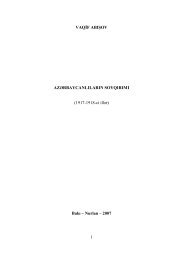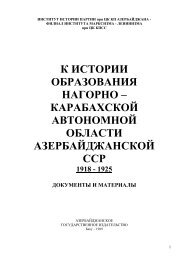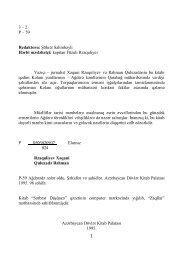ARMENIAN - Erevangala500
ARMENIAN - Erevangala500
ARMENIAN - Erevangala500
Create successful ePaper yourself
Turn your PDF publications into a flip-book with our unique Google optimized e-Paper software.
liked Romain Rolland, Auguste Rodin... it's an endless<br />
list o f great personalities who all adored this femme<br />
fatale. She fascinated men.<br />
Unfortunately in her personal life as a mother she was<br />
less lucky. Her daughter Anna Maria (from Gustav<br />
Mahler) died at the age o f five. From Walter Gropius, the<br />
famous creator o f the "Bauhaus" she had another daugh<br />
ter, Manon, in 1916. She also died at a very young stage.<br />
In 1918 she became, still married with Walter Gropius,<br />
pregnant by Franz Werfel. The child, named Martin, only<br />
lived ten months. A series o f personal tragedies.<br />
Why is this excurse to failed motherhood and painful<br />
pregnancies so important for the background o f our prob<br />
lem with Franz Werfel? These facts seem to be the key to<br />
the "40 Days o f Musa Dagh".<br />
While Werfel him self mentions in his "note" to the book<br />
just "famished-looking children, working in an carpet<br />
factory" Alma Mahler-Werfel in her memoirs "Mein<br />
Leben" (Alma Mahler -Werfel "Mein Leben" Fischer<br />
Taschenbuchverlag, ISBN 3-596-20545-x) writes about<br />
the days in Damascus, 1929:<br />
"The owner (ofthes carpet-factory) guided us through his<br />
establishment. We walked along the weaver's looms and<br />
everywhere we saw the starved out children, with pale El<br />
Greco-faces and over dimensioned dark eyes. They rolled<br />
upun the floor, took spools and might, sometimes, have<br />
swept the floor.<br />
Franz Werfel asked the owner about these remarkable<br />
children. "Oh, these poor creatures, I collect them from<br />
the streets and I give them one pisatster per day, so that<br />
thay should not die from starvation. They are children o f<br />
Armenians, slaughterd bv the Turks. I f I do not shelter<br />
them, they would die o f hunger. Nobody cares fo r them.<br />
They can afford nothing, they are to weak... Werfel and I<br />
left the place, nothing from now on seemed to be o f<br />
importance or beauty..."<br />
88<br />
The book by Oliver Hilmes, W ITW E IM WAHN (literally,<br />
"Widow in M adness"), looks into Alma M ahler-W erfel’s diaries<br />
and reveals both her tendency to hysteria and her constantly<br />
growing anti-Semitism. This attitude would seem to have been<br />
more than ju st a remnant from the good old days o f the Empire,<br />
and is on the contrary evidence o f her Aryan/Nazi assumption<br />
o f superiority. In our cultural-historical consciousness, Alma<br />
Mahler-Werfel is a kind o f sexual alter ego to such figures as<br />
Zemlinsky, Mahler, Kokoschka, Werfel and Gropius, and she is<br />
treated as such in Hilmes's study. I f one left aside the artists<br />
mentioned, the book would read like a cheap paperback<br />
account o f the life o f an intelligent, elegant and sensitive oppor<br />
tunist. But it is also the psychogram o f a woman struggling at<br />
once for recognition and sexual satisfaction, a salon lady<br />
drenched with the transient fragrances o f late Romanticism and<br />
Impressionism.<br />
This moving moment provokes, beyond any irony, two<br />
questions:<br />
How is it possible that AD 1929, fourteen years after the<br />
tragic events o f 1915, starved out Armenian children,

















